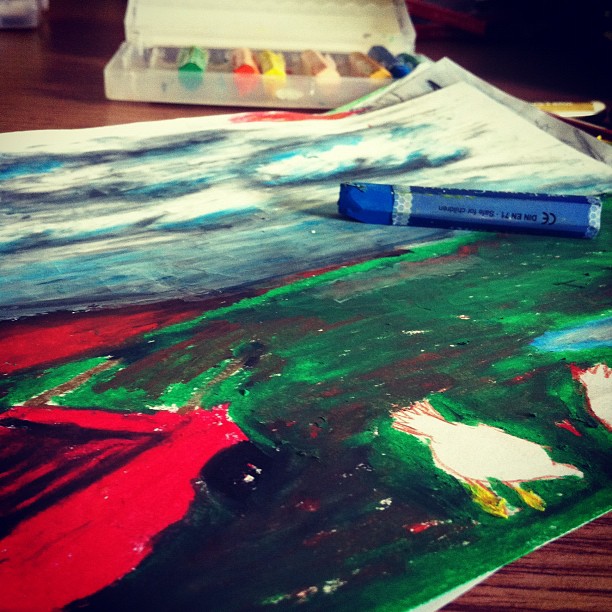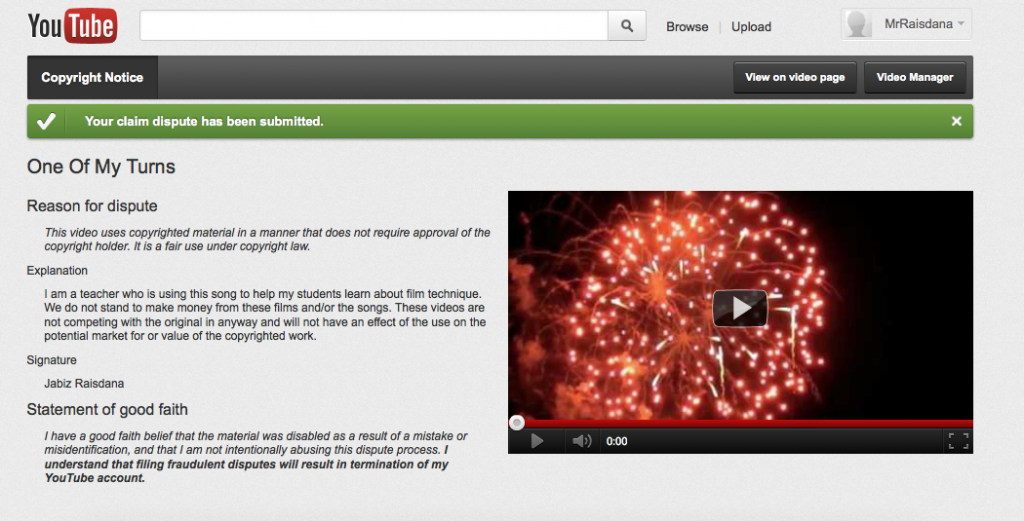I had two eye-opening experiences this week, both really got me thinking about online sharing, curation of digital versus “real” work (E-portfolios) , and overall student learning, both in terms of motivation for and expressions of. The first was the grade 10 MYP Personal Project exhibition, the second my daughter, Kaia’s, student-led conference for her PYP Kindergarten class.
I will start with Kaia. This was her second student-led conference, and again I was very impressed and proud of her autonomy and independence. After greeting me at the door, her teacher handed Kaia a checklist which Kaia had filled in with the different examples of work she wanted to show me at the various stations: Portfolio, Math, Reading, Art, etc… Kaia proceeded to take my hand and lead me to her favorite spots. The first was her portfolio, at which she carefully and deliberately articulated her learning. She was a bit nervous (Still not sure how they can be nervous at that age) but she did a great job of explaining what we were looking at and was able to answer nearly all of the questions I fired at her! (Not sure if having your parents as teachers is a blessing or a curse.) She was confident and proud of herself and her work. We must have spent at least fifteen minutes discussing her learning. It was awesome to watch.
Next stop, she led me to a shiny iMac where she adeptly opened a folder called Kaia and hit play on a Keynote presentation. Before I continue, let me say that the presentation was beautifully made and showed tremendous amounts of work and time. Each slide had photos, text and little video clips of Kaia playing tennis, reading, acting, singing and more, but the weirdest thing happened–after twenty minutes of her being engaged and talking about her learning in a non-digital format, she became silent. We simply sat and watched a ten minute slide show. When I tried to ask questions, she said, “just watch daddy.”
Of course I see the irony here– part of my job is to promote and facilitate technology and the use of digital tools to enhance student learning. We have spent countless hours discussing what this looks like at every level of our school, but here I was wishing we could just turn off the video and go back to when she was telling me about what an herbivore is, or the features of a Triceratops. What is going on here? Let’s take a look and start with some questions.
Is a collection of photos and videos an effective use of technology? Is the presentation of an E-portfolio as part of a student-led conference the best use of time? I cannot emphasize enough that this post is not a critique of Kaia’s teachers. She has done an amazing job. Kaia is excited and passionate about everything they do in class. I am sure that the format they use is a standard protocol, that they have worked out in the elementary school. As a player in the decision making apparatus at our school, however, I feel that it is my duty to reflect on how our ideas are carried out.
As I mentioned early, the product itself was great. A well told digital story of my daughter’s learning. It was great to see a slide that had a copy of the book she had written coupled with a short clip of her reading said book. I saw her in the art room, in PE and on the playground. I couldn’t help thinking about a few things as I watched: I wish her grandparents could watch this, I wish I wasn’t watching it now at this conference, I wish I could have seen this unfold throughout the year and not all presented in one package, I wish I could interact with it and leave comments. I wish others– family friends etc…could also interact with it. You guessed it, I wished this portion of the conference was on a blog, and that I had had access to it months earlier.
In a world that is increasingly applying pressure for the digitization of our lives, we must be careful not to go digital for its own sake. Sometimes, most times really, sitting and talking with a five year as she talks about symmetry, while building a perfectly symmetrical house– using blocks, is far better than sitting in silence as you both watch a video of an assembly that happened months ago.
What’s my point? None of this is easy. Finding the balance between the digital and analogue is a major theme for this generation. We cannot, however, assume that one method is better than another simply because it is digitized or “real.” In this case, I really enjoyed watching and interacting with Kaia’s independence and confidence as she showed off her work. I was disappointed, however, when we sat and watched her video. Especially when I knew that in a proper blogging platform, we could have been watching these digital events and interacting with them as they occurred in real time.
Final question–is curation of work in a digital format really using technology to enhance learning? Every school in the world is grappling with these questions. We are all at different levels of understanding and implementation of technology. Our school has made tremendous progress in the two years I have been here, but as we start crossing one bridge, it is time to look ahead and ask what’s next. What if Kaia had shown me content she had created using digital tools? She is an adept photographer and storyteller. I would have loved to have seen a movie that she had made. What if she had interacted with another classroom? What if her peers had commented on her work as well? What if…..
Soon we will have our middle school student-led conferences, and we are working hard on building a structure for students to highlight and eventually curate their work through their blogs. I would hate to see, however, parents and students, simply watching a screen and not talking. A blog should be an ongoing space. A place where work is current, relevant and interactive. While I feel, that our blogs will eventually be great e-portfolios housing a range of student work and learning, I do not think that they serve much of a purpose in a student-led conference. Unless, the students are coached on how to navigate their work on a blog, so as to engage their parents in conversations, not simply click from link-to-link.
The second experience I had this week, was the grade 10 MYP Personal Project exhibition. Once again an incredible display of student learning, motivation, and independence. A huge round of applause to everyone who was involved. The weeks of work and learning were evident in all the displays. Students had created original perfumes, compositions for piano, iBooks about golf and more. Students confidently presented their guiding questions and were able to answer all the annoying questions I asked.
All except for one? Is this online? Not one of the grade 10 students had thought to share their work and final product online. True that the majority of them had used their blog as a process journal, properly tagging their posts and keeping impressive running diaries of their progress, but not one student had felt the need to share their final product with a global audience. They saw nothing wrong with spending weeks on a project, building a display that would last only two days and then being done with it. Up and down. Gone! Why is this?
I think students are still thinking of everything they do at school as a part of school. Even their personal projects, which are meant to be based on a passion and personal interest are nothing more than a school assignment to be shared and evaluated by teachers and perhaps a few peers. Why? How do we change this? How do we instill in students that what they create has value in a larger context?
I want to teach kids that their content has a place on the web? It has value and they should look forward to sharing their ideas and content, rather than being afraid of the exposure. If you spend over ten weeks writing an original piano composition, doesn’t it make sense to post it on Soundcloud and have it live on the web? If you wrote an iBook on golf, why not go the extra step and put it on iTunes so other people can download it?
I will be talking to the grade 10’s today about the ephemeral nature of their projects. Ten weeks of work, two days of presentations and then gone! Vanished like dust in the wind. I hope that they see the value of etching a space online for their minds, for the work, for themselves. Like Kaia’s conference, there is definite value in the physical personal project exhibition. It is just disappointing that they are gone. I cannot go home and listen or watch and comment more deeply on what I saw. I cannot share their work with you or your students. We cannot build conversations and community around their content.
In conclusion, I hope I have laid out the value of online spaces for students from kindergarten to grade 10. Give a kid a blog as a space to tend their garden. Let them learn how to be just as independent and confident online as they are off. Teach them how to balance the digital and the organic. Let them present and talk to peers face-t0- face, but also create lasting portfolios of their work online. This is the road ahead. These understandings are what people mean when they speak of 21st century skills.
Would love to hear your ideas. Share your experiences in the comments below.




